Game Developer Other Ocean’s #IDARB
Head of Development Mike Mika speaks about the upcoming crowdsourced title

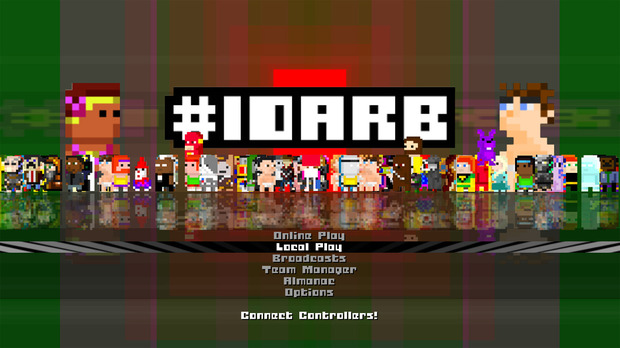
From their headquarters Emeryville, CA and three studios in Canada and Northern California, game developers Other Ocean work on a multitude of projects that span mobile, handheld and console games. They’ve produced numerous noteworthy titles over the years, but their recent project goes beyond traditional development and really speaks to their understanding of how to create a successful game that makes the most of today’s flexible technological landscape.
Called #IDARB (which stands for “It Draws a Red Box”), the game was first conceived earlier this year and it started with a tweet. Other Ocean describes the game as a “constantly-evolving, crowd-sourced, minimalist game mechanic sketchbook.” Each player’s character is customizable with an editor tool, but don’t let the pixels fool you. This game is filled with delightful competitive chaos. Up to eight players are separated into two teams, who are challenged with putting a ball into the other team’s goal. Each match is about six minutes long and broken into quarters. During the match, spectators are able to participate via Twitter and Twitch using “hash bombs”—for example, tweeting “@idarbwire #WJA1 you #light up my life” activates the #light hash bomb and turns off the lights in the arena. This social media spectator participation is an apt feature to a game that started off as a collaboration between Other Ocean and the internet.
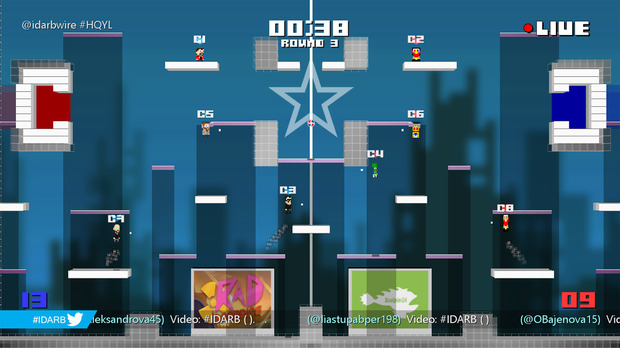
After playing the demo at the recent
E3 fair in Los Angeles, CH sat down with Other Ocean’s Head of Development, Mike Mika, to talk about the creation of the game and its unique features. In addition to this role, Mika is also one of the studio managers, an engineer and a game designer who even keeps the creativity brimming at home (see how he
hacked Donkey Kong for his daughter).
Where did the idea for this game come from?
It started on January 3rd of this year. I posted a picture on Twitter of a red box in the middle of the screen. I was just looking to start a side project and get some advice from my friends. So my tweet said something like “It draws a red box. What should I do next?” What I didn’t expect was the amount of feedback I would get from the people following me on Twitter. I didn’t have that many followers at the time, maybe about 200. Now that the game has been shown, I’ve got about 1,300 followers. At the time, the initial feedback was manageable, so just on a lark, I tried putting everything in.
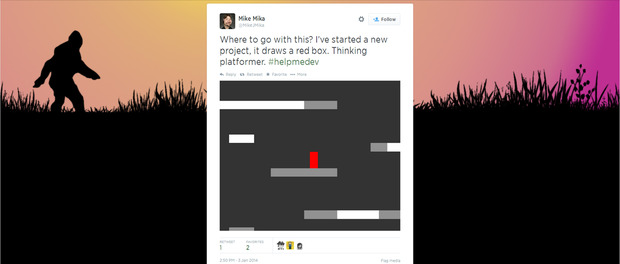
About halfway through, I was thinking this could turn into a really great
Game Developers Conference session, where I could talk about how crowd design can be a horrible thing, since I’ve worked on projects with multiple designers with varying degrees of success. It seemed like the more people invited to design—the more cooks in the kitchen—the worse the design turned out. I thought this would be a profound extreme exercise of “too many designers in the kitchen.” So I was expecting this [crowdsourced game design project] to be fairly horrible, but it actually turned out to be just a terrible exercise, since something really incredible happened about a month in. The game just kept getting more impressive and fun to play. People in the office started to play it. We started to invite people outside the office to come in and just throw in ideas. It just kept getting better and better. There’s a level of, as someone described it, “crowd design but with a monarchy” because I do take what people bring to me and I interpret it into the game. So it’s not like I’m just putting in exactly what they say, because they don’t give very much detail. I try to acclimate the idea into the game. However, none of the ideas that have come over have been so ludicrous that we couldn’t find a way to put them in.
Other Ocean works on many other projects. How large is the #IDARB team?
The #IDARB team is mostly two people, myself and Kevin Wilson, plus whatever spare time everybody else in the studio can throw at it. A lot of the characters were created by the other guys in the studio. Another example, one of our engineers, who’s really good at making websites, quickly put together the #IDARB website the Friday before GDC back in March. So it’s really been contributions from all over the company.
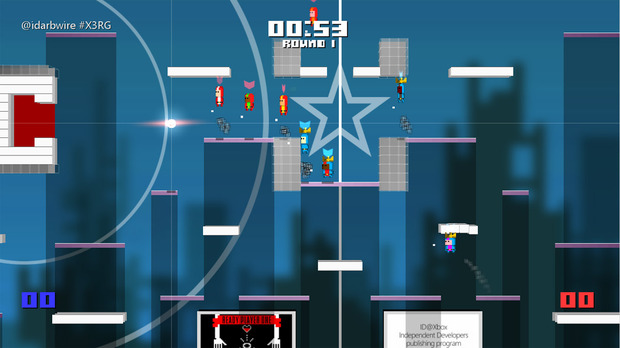
Has the game evolved much since the original suggestions?
The first version of the game was almost going to be a morality platformer because Tim Schafer of Double Fine
suggested it. And we were like, “Oh OK, that could be really fun.” And then shortly after that, somebody suggested that all the boxes looked like soda cans, so they thought it would cool if you could shake the soda cans and make them explode or rocket around. Not too long after that, Brandon Sheffield of Necrosoft Games suggested putting a ball in it. So we put a ball in it and that changed everything! Suddenly, it became this multiplayer sport and it got really addictive. We kept the soda fizz in, but there’s no morality stuff in it anymore. It came to life once the ball got into the game and turned it into this hardcore sport with Super Mario style platforming.
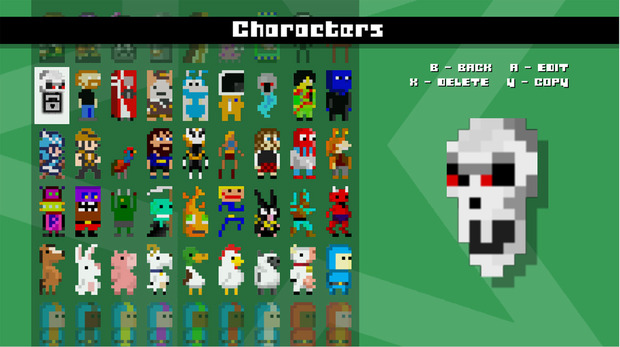
In the game, there are two teams each with customizable characters. How are players able to create their own characters?
Early on, they were just colored boxes. Jeff Nachbaur, Executive Producer and Glen McKnight, Senior Designer, offered to make some characters. So I gave them the criteria, “Make them 8×16. Just super-pixelated right now until we decide what we’re going to do.” And so they started making lots characters. They were having such a good time making these characters, we thought it’d be nice to put in an editor to let other people do it as well.
And while we were doing that, we were trying to figure out what we would use the Xbox One Kinect for. Since our characters are so small, 8×16, we thought they could probably be converted to a QR code, which would be shareable with friends and we could print them at GDC and have people try it out. In a matter of two days, we implemented the QR code generator, the character creator, and, even by the end of it, we decided to put the character creator on the website as well. This idea sparked on a Thursday. By Monday, we had people showing up at GDC with home printed versions of their QR code to try out their characters. We knew we were on to something pretty big at that point.
Now we’ve got hundreds of characters on the website. The character creator has become one of the most appealing aspects for the fans of #IDARB. They keep cranking out these characters and it’s amazing to watch. We’ve seen people online go from beginner artists to really accomplished pixel artists in the span of two months.

During a match, spectators are able to participate using “hash bombs.” What was the inspiration for this?
That was one of the earliest ideas we had for the game because of the exchange we were having on Twitter. First, we thought it would be great to have a running ticker so that we could see everyone talking about #IDARB during a live game. Then it dawned on us; it would be great if they could affect the game. This was before we had seen the “
Twitch Plays Pokemon” experiment. I think a lot of people in the video game community were having these types of thoughts around the same time, but approaching it from different directions. Eventually we figured out we could create a game UID. Every game you start gives you a very unique ID. It’s a hash code that can go in the upper lefthand corner and is very specific to that game session. If people tweet to that game session with the hash code and give it “hash bomb” commands, we figured out we could affect the game.
We added Twitch just before E3, because, obviously, ”Twitch Plays Pokemon” was awesome. With Twitch integration on the Xbox One, we thought, “Why can’t we just cross the streams here too?” So now we have the ability for people to affect a live game from both sources, Twitter and Twitch.
By the time we got to the show, this feature had just been implemented. When we got there, we were invited to be on the Twitch main channel. We were a little worried because we hadn’t fully tested the live Twitch spamming of this game. So we sat down (I was kind of sweating it a bit) with 30,000 people watching! The minute we told them what they could do in the game, the audience just spammed it hard. The game almost crashed, but it survived! 30,000 people throwing every command you could think of at it. So we had monsters coming out. It was snowing. There was Rick Astley dancing across the screen. Characters turning into clowns. It was insanity. We got a few goals in, but it was pretty tough.
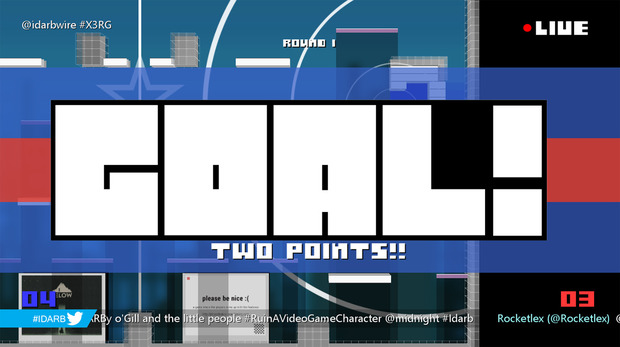
How do you balance the potential chaos caused by the spectators and the fun that players are experiencing during the match?
It’s new ground, so we’re trying to figure that out. One thing we’ve noticed is we won’t let any affect play over itself. If we space all of the affects by about three to seven seconds or so, everybody can get something in even if there are thousands of people watching, but also it doesn’t prohibit the gameplay; players can still score.
These features we put into the game affect both teams. It’s important that there’s never a bias. Also, the effects shouldn’t stop players outright from doing something. The effects should just bother a little a bit. We’re trying to make sure these things are just a little annoying, but you can still play through it, so nothing stops the game.
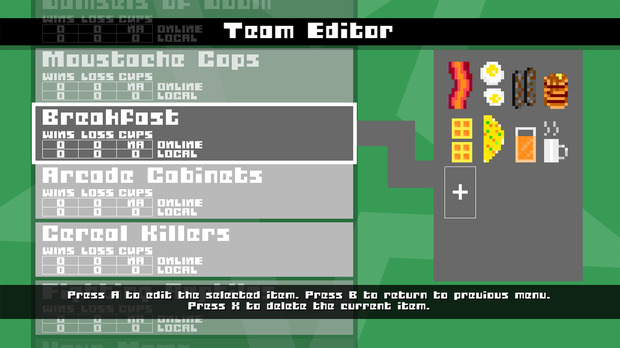
Are there other types of engagement players should look forward to when the game is released?
We are a little worried about being too crazy, but at the same time, we have a few more ideas. We do want to make sure that tournament play and online play are in there, so we can have online tournaments and more asynchronous play experiences, like being part of big round-robin tournament.
It’ll be couch versus couch with two Xbox Ones connected online. So it will still be a local party game, but online as well. We think local multiplayer is way more fun than online multiplayer. There’s something more genuine and interesting about it to us. But everyone really wants online as well, so we’ll support both. The teams can be any configuration, four versus four, seven on one, but we want to make sure that there’s still that local sense of you and your friends getting together as a team in one room fighting another team.
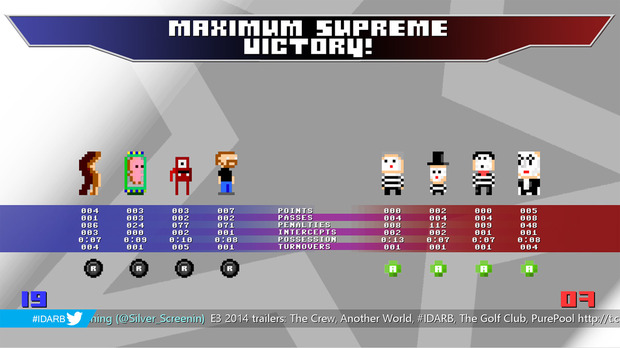
How has this “collaboration with the internet” affected you personally as a game creator? Has it surprised you in any way?
It’s completely surprised me. In my career, I’ve worked on over 130 games and this is one of the most fun games I’ve worked on. The immediate response and gratification I’m getting from people who are playing it is probably the best I’ve ever had working on a game. I’ve been surprised by ideas that were thrown my way. I’ve thrown away my personal opinion about some of these ideas and just implemented it, realizing later that it was the right idea to put in. This has taught me that I need to be a little more open about where these ideas come from. Personally, I’ve grown from it. And it’s also probably the most satisfying project I’ve worked on in my career.
Other Ocean aims to release the game in August for Xbox One and the PC later this year. Although each version will be differentiated to suit the capabilities of the platform, it may be possible for Xbox One and PC players to compete with each other across platforms.
Images courtesy of Other Ocean












